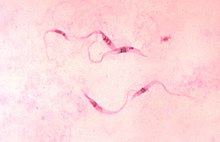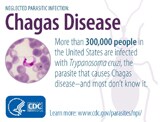Trypanosoma cruzi is a species of parasitic euglenoid protozoan. Amongst the protozoa, the trypanosomes characteristically bore tissue in another organism and feed on blood, and lymph. This behaviour causes disease or the likelihood of disease that varies with the organism: for example, trypanosomiasis in humans (Chagas disease in South America and sleeping sickness in Africa), dourine and surra in horses, and a brucellosis-like disease in cattle. Parasites need a host body and the haematophagous insect triatomine (descriptions "assassin bug", "cone-nose bug", and "kissing bug") is the major vector in accord with a mechanism of infection. The triatomine likes the nests of vertebrate animals for shelter, where it bites and sucks blood for food. Individual triatomines infected with protozoa from other contact with animals transmit trypanosomes when the triatomine deposits its faeces on the host's skin surface and then bites. Penetration of the infected faeces is further facilitated by the scratching of the bite area by the human or animal host.
Trypanosomiasis in humans progresses with the development of the trypanosome into a trypomastigote in the blood and into an amastigote in tissues. The acute form of trypanosomiasis is usually unnoticed, although it may manifest itself as a localized swelling at the site of entry. The chronic form may develop 10 to 20 years after infection and affect internal organs (e.g., the heart, the oesophagus, the colon, and the peripheral nervous system). Affected people may die from heart failure.
Acute cases are treated with nifurtimox and benznidazole, but no effective therapy for chronic cases is currently known.
Life cycle

The Trypanosoma cruzi life cycle starts in an animal reservoir, usually mammals, wild or domestic, including humans. A triatomine bug serves as the vector. While taking a blood meal, it ingests T. cruzi. In the triatomine bug (Triatoma infestans) the parasite goes into the epimastigote stage, making it possible to reproduce. After reproducing through binary fission, the epimastigotes move onto the rectal cell wall, where they become infectious. Infectious T. cruzi are called metacyclic trypomastigotes. When the triatomine bug subsequently takes a blood meal from a human, it defecates. The trypomastigotes are in the feces and are capable of swimming into the host's cells using flagella, a characteristic swimming tail dominant in the Euglenoid class of protists.
The trypomastigotes enter the human host through the bite wound or by crossing mucous membranes. The host cells contain macromolecules such as laminin, thrombospondin, heparin sulphate, and fibronectin that cover their surface. These macromolecules are essential for adhesion between parasite and host and for the process of host invasion by the parasite. The trypomastigotes must cross a network of proteins that line the exterior of the host cells in order to make contact and invade the host cells. The molecules and proteins on the cytoskeleton of the cell also bind to the surface of the parasite and initiate host invasion. When they enter a human cell, they become amastigotes. This is another reproductive stage. After reproducing through binary fission until a large amount of amastigotes are present in a cell, pseudocysts are formed there. The amastigotes then turn back into trypomastigotes, and the cell bursts. The trypomastigotes swim along to either infect other cells or get sucked up by other reduviid bugs.
Pathophysiology

Myocardial biochemical response
Subcellular findings in murine studies with induced T. cruzi infection revealed that the chronic state is associated with the persistent elevation of phosphorylated (activated) extracellular-signal-regulated kinase (ERK), AP-1, and NF-κB. Also, the mitotic regulator for G1 progression, cyclin D1 was found to be activated. Although there was no increase in any isoform of ERK, there was an increased concentration of phosphorylated ERK in mice infected with T. cruzi. It was found that within seven days the concentration of AP-1 was significantly higher in T. cruziâ€"infected mice when compared to the control. Elevated levels of NF-κB have also been found in myocardial tissue, with the highest concentrations being found in the vasculature. It was indicated through Western blot that cyclin D1 was upregulated from day 1 to day 60 post-infection. It was also indicated through immunohistochemical analysis that the areas that produced the most cyclin D1 were the vasculature and interstitial regions of the heart.
Conduction abnormalities
Conduction abnormalities are also associated with T. cruzi. At the base of these conduction abnormalities is a depopulation of parasympathetic neuronal endings on the heart. Without proper parasympathetic innervations, one could expect to find not only chronotropic but also ionotropic abnormalities. It is true that all inflammatory and non-inflammatory heart disease may display forms of parasympathetic denervation; this denervation presents in a descriptive fashion in Chagas’ disease. It has also been indicated that the loss of parasympathetic innervations can lead to sudden death due to a severe cardiac failure that occurs during the acute stage of infection.
Another conduction abnormality presented with chronic Chagas’ disease is a change in ventricular repolarization, which is represented on an electrocardiogram as the T-wave. This change in repolarization inhibits the heart from relaxing and properly entering diastole. Changes in the ventricular repolarization in Chagas’ disease are likely due to myocardial ischemia. This ischemia can also lead to fibrillation. This sign is usually observed in chronic Chagas’ disease and is considered a minor electromyocardiopathy.
Another class of electrocardiomyopathies associated with Chagas’ disease is the bundle branch block. These include incomplete left bundle branch block, complete left bundle branch block and complete right bundle branch block. These defects occur because of a lack of conduction and insulation in the bundle branches that connect the AV node to the purkinje fibers, which mediates a concerted contraction of the ventricles. A bundle branch block is usually associated with a change in the electrocardiogram vector. The ECG vector usually runs straight to the apex of the heart, in a bundle branch block the vector runs opposite to the block. Chagasic bundle branch block is presented in chronic Chagas’ disease and is considered a moderate electrocardiomyopathy.
Severe conduction abnormalities associated with Chagas’ disease occurs when a bundle branch block spreads past the bundle of His and creates an atrioventricular block. At this point, the patient presents impaired conduction velocity and mild bradycardia or elicits a Wenckebach phenomenon depending on the degree of AV block. Also presented with severe Chagas’ cardiomyopathy but lying outside the scope of this article are dyspnea and syncope.
Epicardial lesions
Epicardial lesions are also associated with Chagas’ disease. These lesions include milk spots, Chagasic rosary, and villous plaque. It has been proposed that these three categories of lesions, although occurring in different areas of the heart and having different histological appearances, are all epicardial reactions to chronic inflammatory responses. They could be the direct cause of conduction problems, thrombosis problems, or even the root of ventricular remodeling.
Upon examination, milk spots are characterized as white areas with precise borders on ventricular epicardium and they often appear on the right ventricle. Microscopic examination of the anatomy of milk spots shows that they are composed of parallel arrangements of densely compacted collagen fibers with no vasculature. The location of these fibers may lead to interference with the conduction of current through the heart. It has been proposed that milk spots are actually scars, due to the lack of inflammatory cells and vascular proliferation. Milk spots are not purely indicative of heart conditions related to Chagas’ disease, but are also associated with many chronic heart diseases.
Chagasic rosary refers to small round granules deposited along the coronary vessels. These small round granules are arranged like a string of beads, hence the term rosary. The chagasic rosary structures are composed of the same collagen fibers that form milk spots, the difference being their size and location. The location of chagasic rosary may play a role in the thromboembolism associated with Chagas’ disease. Chagasic rosary is unique to Chagas’ disease; however, it should not be considered a pathognomonic lesion of the chagasic etiology.
Villous plaque is characterized by exophytic epicardial thickening, meaning that the growth occurs at the border of the epicardium and not the center of mass. Unlike milk spots and chagasic rosary, inflammatory cells and vasculature are present in villous plaque. Since villous plaque contains inflammatory cells it is reasonable to suspect that these lesions are more recently formed than milk spots or chagasic rosary.
Cardiac manifestations
Researchers of Chagas’ disease have demonstrated several processes that occur with all cardiomyopathies. The first event is an inflammatory response. Following inflammation, cellular damage occurs. Finally, in the body’s attempt to recover from the cellular damage, fibrosis begins in the cardiac tissue.
Chagas’ disease can affect myocardial function by causing heart failure syndrome. Depending on which side of the heart is affected by chagasic cardiomypopathies, there are different clinical manifestations throughout the body. Associated with right side damage are edema, ascites, hepatomegaly, and pathologic jugular turgor. These symptoms are due to inadequate removal of venous blood. Associated with left side damage are pulmonary congestion and low cardiac output. Also observed in heart failure syndrome is apical aneurysm, sometimes with a diameter between 2â€"5 cm, weakening the endocardial-pericardial junction.
Arrhythmic syndrome is also a cardiomyopathy clinically associated with Chagas’ disease. The alterations of the contactile rhythms spur from atrioventricular and intraventricular conduction defects, dysfunction of the sinus node, primary and secondary ventricular repolarization disturbance, fibrosis and inflammation, autonomic dysfunction, and endothelial dysfunction.
There is some evidence that chronic Chagas disease also can cause autonomic dysfunction, including impaired regulation of heart rate in response to various physiological stresses such as orthostatic testing or the Valsalva maneuver.
Another cardiomyopathy found in nearly all cases of chronic Chagas’ disease is thromoembolic syndrome. Thromboembolism describes thrombosis, the formation of a clot, and its main complication is embolism, the carrying of a clot to a distal section of a vessel and causing blockage there. This occurrence contributes to the death of a patient by four means: arrhythmias, stasis secondary to cardiac dilation, mural endocarditis, and cardiac fibrosis. These thrombi also affect other organs such as the brain, spleen and kidney.







0 comments:
Post a Comment